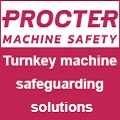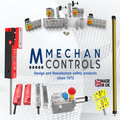
Posted to News on 2nd Jul 2008, 09:56
What to do when specifying industrial robots and workcells
Stirling Paatz, of robot integrators Barr & Paatz, provides 12 tips for avoiding mistakes when specifying industrial robots and robot workcells.
At first glance, industrial robot specification sheets look fairly straightforward. Typically, there is a picture of the particular model, looking sleek and stylish, unblemished by external cabling, end-of-arm tooling, feed mechanisms and safety guards. Then there are the quoted figures: number of axes, maximum payload, reach, repeatability, maximum speed, cycle time and installation footprint. All these specifications seem comparable, manufacturer to manufacturer, so it is like buying a car or a TV, surely...
Actually, it is not. During my many years designing and commissioning robot workcells, I have encountered many mistakes and oversights when specifying a robot for a particular task. Some I made myself, in the early days when robotics was still an unfamiliar technology; most I had to fix for frustrated robot buyers, whose machines would not do what they were supposed to do. So I have assembled a list of a dozen things to do and things not to do, partly to help those new to robotics avoid the worst pitfalls, but mainly to emphasise that specifying and building robot workcells is a specialist job, best left to specialists. It is what I do.
1. Do not overestimate speed performance
Although manufacturers' speed data is usually honest, a robot will not operate at full speed throughout its work cycle, nor will it interact with the workpiece at maximum speed. You also need to allow for the gripper to secure and release the workpiece, which slows the cycle time. True, some manufacturers do quote cycle times, based on a benchmark function, but this relates to a simple pick-and-place operation, not necessarily your application. The only way to get an accurate estimate of speeds and cycle times is to pre-design an actual workcell simulation, which I will come to later.
2. Do make allowances for the end-effector
The end-effector is the end-of-arm-tooling (EOAT) that grips the workpiece, usually by means of grippers, suction or magnetics. The gripper or vacuum cup needs to pick up the workpiece with sufficient force for the weight of the object, but without too much aggression that it marks or damages the object. You also need to take into account the robot's acceleration forces during a high-speed work cycle, which can actually lever open grippers or peel the workpiece straight off the vacuum cup. The weight of the end-effector, together with its cable or hose, needs to be added into the equation, when specifying the machine, which leads to...
3. Do not underestimate payload requirements
A common specifying error is to omit the weight of the end-effector and associated cabling when calculating payload. A robotic gripper, which employs jaws or fingers to hold the workpiece, can weigh several kilos, which is why lighter vacuum cups are often specified, although they require vacuum generators and hose that must also be factored into the payload. Kinetic forces generated by off-centre payloads, as well as torsional forces created at the extreme end of the robot arm's travel, should also be accommodated in your calculations. Remember too that the maximum payload is just that, an occasional maximum limit, not the normal operating capacity.
4. Do take the robot arm into account
If you have ever played snooker in a room that was too small or tried to saw wood tight against a wall, you will appreciate what I mean. A robot, especially a six-axis articulated robot, has an arm mechanism very similar to a human arm, complete with jointed elbow. It has a large work envelope, almost spherical in shape, and the end-effector can be manipulated to any position or orientation within that envelope. However, when laying out the workcell, many people focus solely on the end-effector, forgetting the rest of the arm and particularly that flying elbow. Given the speed of movement, there is great potential for mechanical damage if the rest of the arm is overlooked.
5. Do not overlook cable management
Cable management is a major installation issue that is often forgotten. Although it is possible to channel cables and pneumatic hose internally through the robot base and arm, in most cases some level of external cable routing is required. Here, the very flexibility of the robot arm and its high-speed movement pose a problem, since you need to plan the cable routing to avoid snagging, tangling and stressing sensitive connecting wires. Designing cable runs to allow unrestricted movement of the robot manipulator is quite an art and happily there are flexible cable-carrying systems available, which are able to withstand the twisting movement, high-speed friction, and harsh operating environments associated with such applications.
6. Do provide for operating conditions
The conditions in which the robot will be operating, whether it is a dusty, greasy shop floor or a pristine cleanroom environment, is an important consideration when specifying the IP rating, or ingress protection. Levels of protection extend from a basic IP54, through the more standard water- and dust-tight IP65, which is ideal when installing next to a machine or workstation, through to special versions equipped with gaiters and external coverings for laboratory, cleanroom, paintshop or hazardous applications. Enhancing the IP rating adds to the cost, so consider the application carefully; just because it is food processing, the robot might be handling product that is already wrapped, so advancing the spec may not be necessary.
7. Do not forget workcell safeguarding
Often overlooked in the initial specifying and costing, yet absolutely critical from a safety compliance angle, are the mechanical and electronic safeguards. Robots are virtually silent and extremely fast in operation and, unlike conventional automated machinery in which the operating envelope is clearly defined, most robotic workcells are individual in configuration, so bespoke safeguarding is usually required. HSE guidelines provide standards for perimeter fencing, interlocking devices, opto-electronic systems, safety light curtains and emergency stop actuators, which we adhere to when building highly sophisticated workcell safeguarding.
8. Do factor in the peripheral costs
Far be it for me to dissuade potential robot buyers by pointing out hidden costs, because robotic applications can, and usually do, justify themselves on financial grounds alone. But do not overlook peripherals, like teaching pendants, interface boards and software licenses, when budgeting for an installation. If you omit these from your initial order, then run over budget and incur delays awaiting delivery, question marks are likely to be raised. Teaching pendants cost 1000 or so and you require them for programming purposes, but you do not need one for every machine. Software licenses are often required for every machine and you will need plug-in cards for network communications, so be sure to compare competitors' pricing.
9. Do not confuse accuracy with repeatability
Repeatability data always looks impressive at +/-0.02mm or so and, indeed, it is. But do not confuse accuracy with repeatability and expect the same precision, because repeatability figures are always better than those for accuracy. Repeatability refers to how precisely a robot can return repeatedly to a given position, following the same approach vector. Accuracy relates to how closely a robot can move to a specified X-Y-Z position in the work envelope. If, say, a robot gets to within 0.5mm of that specified position, that would be its accuracy; however, once that position is programmed into the controller memory and, each time the robot is sent there, it returns to within 0.02mm of its taught position, that would be its repeatability.
10. Do exploit the robot's full capabilities
Current trends toward shorter product life cycles and more versatile manufacturing mean that, when selecting an industrial robot, it pays to bear in mind possible future duties. Unlike fixed automation, robots offer inherent flexibility and can be re-programmed and redeployed any number of times, over an average 15-year life cycle. Also, modern robots, especially six-axis models, are capable of so much more than simple pick-and-place duties, since the arm's ability to reach over and around obstructions and twist or tilt the end-effector make it suitable for complex functions. The extensive command sets embedded into the robot controller and pre-written subroutines also make programming easier and more economical.
11. Do not buy a robot solely on price
The fact that a modern robot costs one-quarter of what it did a decade ago means that the technology is already more accessible and affordable. So do not be tempted to buy solely on price, but look instead for best-value performance. The various manufacturers have different strengths in different robot classes, so check out their credentials in the payload capacity you are buying. Equally, it does not make financial sense to over-engineer the solution by specifying functionality you do not need. A six-axis robot is highly capable, for instance, but for many routine pick-and-place tasks a four-axis machine would be equally capable and considerably cheaper.
12. Do request a robot workcell simulation
When planning and specifying a new project, we invariably use an advanced 3D design package to simulate the entire workcell and verify that our initial calculations and specifications are correct. In most cases we use a simulation, not least because it demonstrates graphically to the client that our proposed solution will work. It allows us to check the reachability of all positions, optimise cycle times, and generally observe the other points covered in this article. So convinced are we that this is the way forward for those new to robotics, that we offer a 3D workcell simulation of any prospective application for just 1500, including a video. Then if you go ahead with the project, we will discount that figure off the final project price.
To contact Stirling Paatz, email [email protected].
Want the latest machine building news straight to your inbox? Become a MachineBuilding member for free today >>
GLOBAL

















